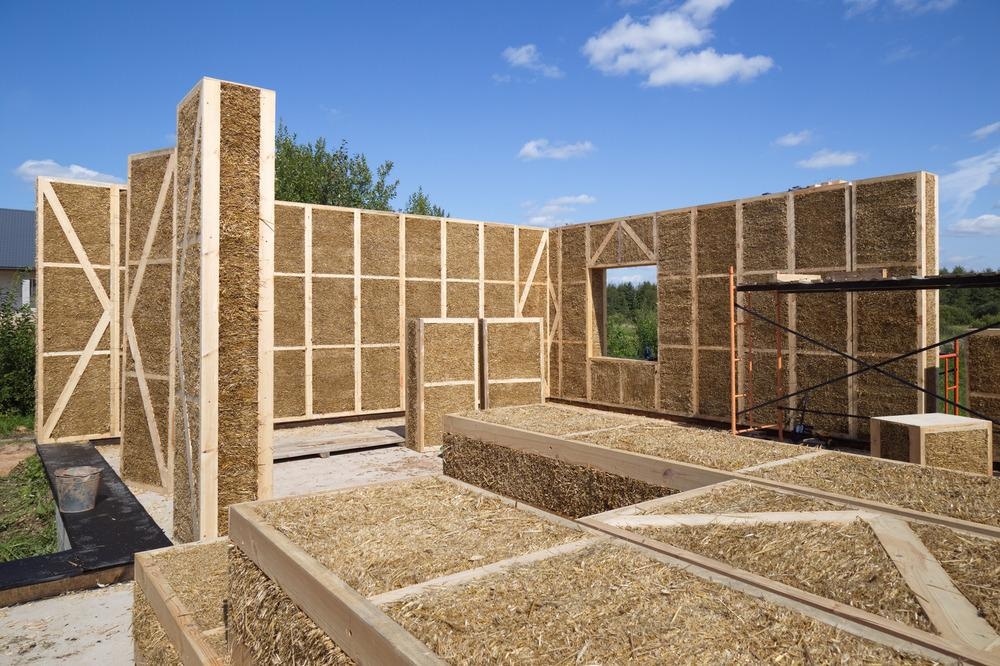Straw buildings are often associated with times gone by and technologies that we have since surpassed. However, recent years have seen a resurgence in building with this natural material. This revival is being fueled by the urgent need to cut the emissions of the construction sector and straw buildings provide a viable option to sustainably cut the industry’s carbon footprint. Additionally, new building technology means that straw buildings are now stronger than ever.

Image Credit: ushi/Shutterstock.com
Straw Buildings Do Not Blow Down
Many countries across Europe have begun to switch from unsustainable and environmentally damaging construction materials to the cost-effective and low-carbon footprint option of straw. France and Russia, in particular, have been early to adopt new straw construction technology, reviving a building material of the past to ensure a low-emissions future.
Contrary to popular opinion, straw buildings are structurally sound and are perfectly viable as building materials for houses and other buildings. Recent projects, such as BaleHaus, constructed in Bath, UK, have demonstrated how the combination of the natural building materials of straw and wood can produce strong houses that perform beyond the requirements of building regulations.
BaleHaus, for example, was constructed of straw tightly packed into prefabricated rectangular wooden wall frames which were lime-rendered, dried, and slotted together to create the final construction. As a result, the house performed exceedingly well under resistance tests, proving its strength, durability, and appropriateness as a building material.
For centuries straw was used as a reliable and durable building material. Currently, the world’s oldest straw house stands in Nebraska at 133 years old, demonstrating the potential to construct straw buildings that last a lifetime.
More on Alternative Building Materials: Plastic Bricks: Tackling Plastic Waste and Housing Shortages in Africa
While the use of the material fell out of favor following the boom of the brick and then concrete industry, straw is now seeing a comeback in the construction industry.
It is available in an abundance, is sustainable, has a low carbon footprint, can build strong and durable buildings that further cut emissions by reducing heat loss, and is not associated with the air and noise pollution attributed to building with currently popular materials such as concrete. These benefits have led to the emergence of straw as a building material.
A Revival of Natural Materials Will See the Construction Industry Cut Emissions
The construction industry is responsible for producing a large portion of global emissions. According to recent figures, the construction industry accounts for 38% of global carbon dioxide (CO2) emissions. With the world under increasing pressure to cut emissions to meet the goals of the Paris Agreement, all industries must shift their processes to make them sustainable and carbon neutral.
Given that the construction industry is one of the world’s largest emitters of CO2, it is faced with the challenge of drastically changing its entire process, from sourcing materials, transporting them, the actual construction process itself, and ensuring that the buildings it creates are more energy efficient. As a result, the construction industry has begun to look to the past to natural building materials.
There is a current trend in the construction industry to look to science to revive natural materials and processes. For example, a recent project run by scientists at the University of Plymouth investigated how the ancient process of constructing traditional “cob” buildings could be revived and updated to meet current building regulations.
Similar projects are running in India to revive the use of natural building materials such as mud by improving on ancient techniques to establish new natural plasters with enhanced properties.
The Straw Bale Building by Make Architects
Video Credit: Make Architects/Youtube.com
Straw buildings, in particular, are seeing a resurgence. Already, numerous companies have emerged that design, produce building materials, and construct straw-based buildings. UK-based Straw Works, for example, has been involved in 300 natural buildings projects over the last 25 years and has helped to re-establish straw as a building material in the UK.
The resurgence of natural building materials and methods goes hand in hand with the world’s shift to sustainable practices and renewable energy. A carbon-neutral world cannot be built on environmentally damaging practices and a reliance on materials that are not only attributed to greenhouse gas emissions but also to air and noise pollution.
Concrete alone is a major contributor to air pollution. Concrete production releases vast amounts of dust into the air that is not limited to one location as the mixing trucks that transport the concrete continue to spew concrete dust into the atmosphere as they travel to and from the construction site.
It is vital that not only straw but other natural building materials successfully make a resurgence in order to develop a modern and carbon-neutral construction industry. Modern technology is helping to develop these ancient materials and building methods to help old practices find their place in modern construction.
These research projects will be key to seeing widespread adoption of environmentally-friendly building materials and tackling the emissions of the global construction industry.
References and Further Reading:
About Us. [Online]. Straw Works. Available at: https://strawworks.co.uk/who-we-are/ (Accessed 9 November 2021)
Goodhew, S., Carfrae, J., Hood-Cree, K., Fox, M., Boutouil, M. and Streiff, F., 2019. Building with earth: How we are working to revive an ancient, sustainable building technique. Construction Research and Innovation, 10(4), pp.105-108. https://www.tandfonline.com/doi/abs/10.1080/20450249.2019.1700077
Louise Tickle. (2010). Is straw the building material of the future?. [Online]. The Guardian. Available at: https://www.theguardian.com/education/2010/jul/13/straw-houses-balehaus-bre (Accessed 9 November 2021)
Disclaimer: The views expressed here are those of the author expressed in their private capacity and do not necessarily represent the views of AZoM.com Limited T/A AZoNetwork the owner and operator of this website. This disclaimer forms part of the Terms and conditions of use of this website.